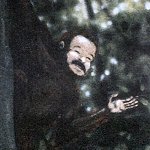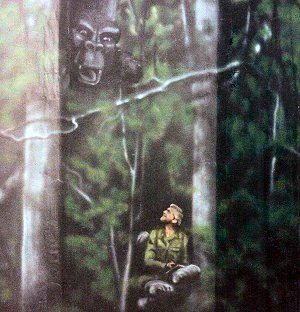It all started while on my first zoo job at the Milwaukee County Zoo. They asked me to paint lichen on a tree trunk in a rhino hornbill exhibit in the aviary. While I was making the green-and-gray blobs, I realized one of them looked sort of like a silhouette of a person, so I added a tall collar and a pompadour and, voila — Elvis!
When the head of the Zoological Society (who would be paying me) heard about it, he voiced his concern that the Zoo might have to deal with pilgrims coming to worship at the miracle tree.
 Maybe the Elvis lichen is what inspired the aviary staff to suggest that I hide a portrait of Ed Diebold, the popular head bird curator, in one of the murals. They got me a photo to work from, and I created the illusion of an orangutan hanging from a tree with Ed’s face on it. It was in a spot that could only be seen by someone inside the cage, so it remained a private joke among the keepers.
Maybe the Elvis lichen is what inspired the aviary staff to suggest that I hide a portrait of Ed Diebold, the popular head bird curator, in one of the murals. They got me a photo to work from, and I created the illusion of an orangutan hanging from a tree with Ed’s face on it. It was in a spot that could only be seen by someone inside the cage, so it remained a private joke among the keepers.
Ed thought it was hilarious, and I don’t think he told the head of the Society about being immortalized in latex paint.
In the next job for Milwaukee, the Apes of Africa exhibit, I hid a life-sized portrait of King Kong peering out of the jungle about 60 feet above the floor.
 Below that, popping through the foliage, is his outstretched hand, and in his palm sits Jan Raffert , who was then the head of the Species Survival Program for Gorillas at the Zoo. He’s dressed in a safari jacket looking up at Kong and calmly taking notes on a pad. The Kong recreation can only be seen by visitors from one extreme location, but the head of the Zoological Society insisted that, if we leave it up, we get rid of the fangs.
Below that, popping through the foliage, is his outstretched hand, and in his palm sits Jan Raffert , who was then the head of the Species Survival Program for Gorillas at the Zoo. He’s dressed in a safari jacket looking up at Kong and calmly taking notes on a pad. The Kong recreation can only be seen by visitors from one extreme location, but the head of the Zoological Society insisted that, if we leave it up, we get rid of the fangs.
“Gorillas have bad enough PR as it is,” he explained.
Most people are familiar with Where’s Waldo, a game in which someone tries to find a small figure hidden in a complicated illustration. I call these hidden objects “inclusions.”
Another inclusion from the same job was in a shore birds exhibit. On the horizon of the ocean is an oil tanker with a thin black line following in its wake. If the public knew that silhouette, they would recognize the Exxon Valdez, the infamous oil tanker that went aground off Alaska in 1989.
Word spread in the wider zoo community, and future clients began asking for inclusions. In an underwater mural at Jenkinson’s Aquarium in Point Pleasant Beach, New Jersey, you can find a mermaid peeking from around some rocks. In a military museum that will remain unnamed, you can find the gopher from the movie Caddyshack poking his head out of a hole in No Man’s Land wearing a World War I helmet. In another aquarium, one can find branches in a dry stream bed at the back of a hippo exhibit that form a tuna fish. In a pioneer mural hanging in a Midwestern university, the driver of the lead covered wagon is none other than yours truly wearing a scruffy hat. I also appear as one of the Marines in a war museum on the east coast, and I included myself and Zoo Director Jim Huebing, a fellow Viet vet, in a photo-op mural in the aviary of the Henry Vilas Zoo in Madison, Wisconsin. I also used Jim’s baby picture for a giant stone Olmec head in one of the rainforest murals.
In yet another military museum, I was asked to recreate the Hürtgen Forest in the 1944 Battle of the Bulge. The central feature in the exhibit is a Sherman tank whose tracks extend back to join the mural where they run further back into the forest. Impossibly (and unintentionally), there is a huge fir tree standing between the two tracks directly behind the tank. No one on staff seems to have noticed yet.
Word seemed to have spread about inclusions at the time I did the main building of the Racine Zoo in Wisconsin. The iron workers building the exhibit doors asked me if it was true that there were some naked ladies hidden in the chaotic jungle murals surrounding the orangutan exhibit.
“Actually, there’s a half-dozen,” I said. They were entertained for weeks studying the random shades of green sprayed on the wall and arguing like children trying to identify bunnies in a fluffy cloud.
Probably the most fun I’ve had with inclusions was having Jim Huebing ask me to paint petroglyphs on the rock work of the train tunnel in his children’s zoo. He was probably expecting historically accurate petroglyphs, but on a whim, I turned them into comic situations between cave bears, saber tooth cats, mastodons and humans.
The most recent inclusion was for a residential client from almost 30 years ago, for whom I had done a Hawaiian beach mural in their rec room. A basement flood had ruined the bottom half, and they had to take the whole wall out. When I was finished with the new Hawaiian scene, they suggested I put myself in the mural somewhere as a signature, so at the far right edge you’ll find a small figure in a straw hat and Hawaiian shirt leaning against the palm tree, sketching.
May this be a portent of the future.